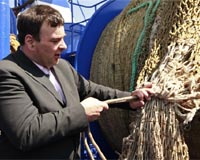 |
Washington DC (SPX) Jun 26, 2009 Without the process of domestication, humans would still be hunters and gatherers, and modern civilization would look very different. Fortunately, for all of us who do not relish the thought of spending our days searching for nuts and berries, early civilizations successfully cultivated many species of animals and plants found in their surroundings. Current studies of the domestication of various species provide a fascinating glimpse into the past. A recent article by Dr. Seung-Chul Kim and colleagues in the June 2009 issue of the American Journal of Botany explores the domestication of chiles. These hot peppers, found in everything from hot chocolate to salsa, have long played an important role in the diets of Mesoamerican people, possibly since as early as ~8000 B.C. Capsicum annuum is one of five domesticated species of chiles and is notable as one of the primary components, along with maize, of the diet of Mesoamerican peoples. However, little has been known regarding the original location of domestication of C. annuum, the number of times it was domesticated, and the genetic diversity present in wild relatives. To answer these questions, Dr. Kim and his team examined DNA sequence variation and patterns at three nuclear loci in a broad selection of semiwild and domesticated individuals. Dr. Kim et al. found a large amount of diversity in individuals from the Yucatan Peninsula, making this a center of diversity for chiles and possibly a location of C. annuum domestication. Previously, the eastern part of central Mexico had been considered to be the primary center of domestication of C. annuum. On the basis of patterns in the sequence data, Dr. Kim et al. hypothesize that chiles were independently domesticated several times from geographically distant wild progenitors by different prehistoric cultures in Mexico, in contrast to maize and beans which appear to have been domesticated only once. Geographical separation among cultivated populations was reflected in DNA sequence variation. This separation suggests that seed exchange among farmers from distant locations is not significantly influencing genetic diversity, in contrast to maize and beans seeds, which are traded by farmers across long distances. Less genetic diversification was seen in wild populations of C. annuum from distant locales, perhaps as a result of long-distance seed dispersal by birds and mammals. Across the three loci studied, Dr. Kim and colleagues found an average reduction in diversity of 10% in domesticated individuals compared with the semiwild individuals. Domesticated chiles in traditional agricultural habits, however, harbor unique gene pools and serve as important reservoirs of genetic diversity important for conserving biodiversity. Share This Article With Planet Earth
Related Links American Journal of Botany Farming Today - Suppliers and Technology
 Traditional Dutch fishermen turn to innovation for sustainability
Traditional Dutch fishermen turn to innovation for sustainabilityThe Hague (AFP) June 23, 2009 Sixth generation Dutch fisherman Louwe de Boer is part of a small group of pioneers abandoning traditional, wasteful methods and embracing innovation as a means of protecting their livelihoods. "It is the only way to survive", says the 42-year-old entrepreneur. He spent two million euros (about 2.8 million dollars) three years ago on new nets that slashed his bycatch -- animals caught ... read more |
|
| The content herein, unless otherwise known to be public domain, are Copyright 1995-2009 - SpaceDaily. AFP and UPI Wire Stories are copyright Agence France-Presse and United Press International. ESA Portal Reports are copyright European Space Agency. All NASA sourced material is public domain. Additional copyrights may apply in whole or part to other bona fide parties. Advertising does not imply endorsement,agreement or approval of any opinions, statements or information provided by SpaceDaily on any Web page published or hosted by SpaceDaily. Privacy Statement |